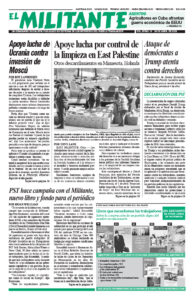Thirty-nine migrants seeking to find a place they could live and make a living died in a Ciudad Juárez, Mexico, detention center March 27 when officials there walked away and left them locked up during a fire. Another 27 remain hospitalized.
Most of the men killed had been picked up that day by city authorities in a crackdown on migrants waiting for their U.S. asylum applications to be reviewed or who had been sent back from the U.S. border. The 15 women in the detention center were evacuated when the fire broke out.
Mexican authorities first tried to blame the migrants, claiming they started the fire because they feared they would be deported. But security footage from the detention center came to light, showing men kicking on the bars of a locked door as their cell filled with smoke. Three uniformed guards can be seen walking past without trying to open the cell door. Among the dead were 18 Guatemalans, six Hondurans, seven Salvadorans, seven Venezuelans and one Colombian.
Because of public outrage, three government migration officials and two private security guards have been arrested, along with the person accused of starting the fire. Reuters reports that Mexico’s top migration official, Salvador Gonzalez, had been alerted to the fire and ordered the migrants not be released. He denies the claim.
Migrants have organized ongoing protests outside the detention center, some wearing placards bearing photos of individuals lost in the fire. On March 30 some who knew him marked the birthday of Joel Alexander Leal Peña, a native of Venezuela who died just shy of turning 21. “I would call it an operation of death,” said his friend Benites. “He committed no crime.”
Ciudad Juárez, across the border from El Paso, Texas, has long been a transit hub, but the deepening crisis of capitalism worldwide and the U.S. rulers’ immigration policies have caused the number of migrants seeking access to the U.S. at the Mexico border to climb sharply.
In March 2020 President Donald Trump approved Title 42, a measure called for by the Centers for Disease Control and Prevention to counter the spread of COVID-19. The law was expanded by President Joseph Biden to cover migrants from Venezuela, Haiti, Nicaragua and Cuba, while offering small numbers the right to emigrate if they travel by air and have U.S. sponsors. Title 42 guts the right of asylum-seekers who get to the U.S. to stay while their claims are reviewed. Some 2.5 million migrants have been summarily expelled.
Biden signed an order April 10 ending a number of special COVID pandemic programs, but left Title 42 provisions on immigration in place until May 11. His administration is moving to implement other deterrents applying to migrants.
Under new rules proposed Feb. 21, asylum would be denied to migrants who show up at the U.S. southern border who haven’t first sought residency in a country they passed through. The rule would establish “a rebuttable presumption of asylum ineligibility,” meaning the burden would lay on immigrants to prove why they shouldn’t be denied asylum.
And on the U.S.-Canada border, a new deal was passed March 24 that expands the right of either country’s rulers to turn away migrants at any point on the border, not just at official crossing points.
In January the bodies of an Indian family, Jagdish Patel, Vaishaliben Patel and their 3- and 11-year-old children, were found frozen to death 13 yards from the border when they attempted to cross into the U.S.
Under the impact of the deepening worldwide crisis, and in the absence of any serious struggle in their home countries to force changes in the conditions they live under, growing numbers look to the U.S. in the hope they can find work here and make a better life for themselves and their families. U.S. government figures say 2.76 million migrants attempted to cross the southwest border in 2022, a million more than the year before.

